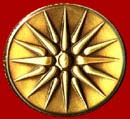More than 2,000
years ago, a roll of papyrus with extensive writings was enshrouded
with a body that was mummified for preservation. The scroll is
the oldest surviving example of a Greek poetry book, according
to scholars who have been studying it. They say the document's
content and unusually fine condition make it the most significant
discovery in Greek literature in several decades.
The papyrus bears 112 short poems called epigrams.
The author is thought to be a prominent writer in the third century
B.C. named Posidippus.
The ancient book came to light several years ago,
but determining its origin has been difficult because little is
known about the Egyptian mummy from which the scroll came.
The mummy, which dates from the second century B.C.,
is in a private collection. Scholars at the University of Milan
acquired the scroll so it could be examined and studied. Next
month, more than 60 experts on papyrus writings, Hellenistic and
Roman literature, art history, and Ptolemaic history will meet
at the University of Cincinnati to present the findings of their
research.
Rare Find
Why would a scroll of Greek poetry be bundled with
an Egyptian mummy?
Kathryn Gutzwiller, a professor of classics at the University
of Cincinnati and the conference organizer, said the practice
was not unusual for that period. Greek and Egyptian cultures became
intertwined after the death of Alexander the Great in 323 B.C.
Posidippus came from Pella in Macedonia and was associated with
the Ptolemies, the Greek rulers who inherited Egypt after Alexander's
death.
In the third century B.C., "mummies were placed
in a kind of papier-mâché casing, for which old papyri
were sometimes used," said Gutzwiller. She and others say
the scroll is an important find for a number of reasons.
The Posidippus papyrus is unusual for its length and
the well-preserved state of the remaining text. Although papyrus
scrolls from Egypt are the major source of new texts of ancient
Greek literature, one of such a high quality is rare, Gutzwiller
noted.
Peter Bing, an associate professor of classics at
Emory University, said the scroll "provides us with the earliest
detailed evidence of how an editor—perhaps the poet himself—organized
a poetry collection."
The epigrams offer new insight into daily life during
the Ptolemaic era, covering events and beliefs such as official
dedications, shipwrecks, omens, and the importance of sporting
successes.
"In a whole raft of poems celebrating equestrian
victories at the great Panhellenic Games such as the Olympics,"
said Bing, "the Milan papyrus makes clear that the Ptolemies
pursued the international prestige of such triumphs with a determination
as single-minded as that displayed in modern times by countries
such as [former] East Germany."
Who Was Posidippus?
Posidippus worked in the Aegean region from about
280 to 240 B.C. He was famous even then as a writer of epigrams.
Epigram means "written upon," said Gutzwiller,
who is an expert on Greek poetry. But more precisely, she explained,
the word refers to a short poem, usually found as an epitaph on
a tomb or featured alongside an object to indicate who dedicated
it to what god and why.
Literary epigrams began to appear by the third century
B.C. These poems were meant to be read or recited for literary
enjoyment, rather than just to commemorate a person or event.
"This particular writing form continued into
the 20th century, and some people with traditional classical training
still do it for fun," said Gutzwiller. While scholars aren't
certain that Posidippus is the author of the 112 epigrams, the
evidence points strongly in that direction, said Gutzwiller. Two
of the poems on the papyrus were already known to scholars and
had long been attributed to Posidippus.
"If the scroll had been written by multiple authors,"
Gutzwiller noted, "we would expect their names to appear
before or beside the poems."
Bing agrees. "Two of the epigrams were
previously known, and both were attributed even in ancient times
to Posidippus. To my mind, nothing in the rest of the poems stands
in the way of seeing Posidippus as the author throughout."
|



